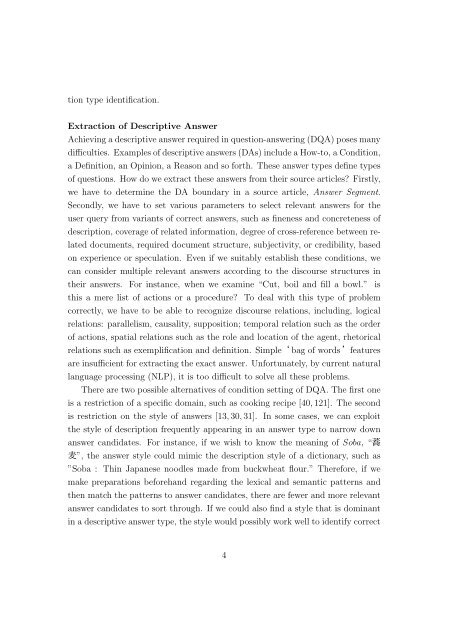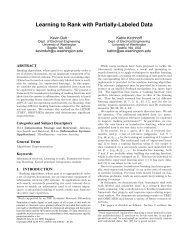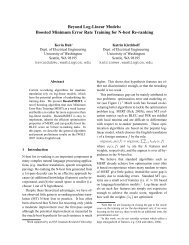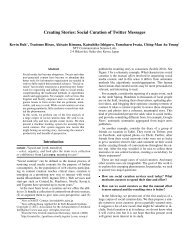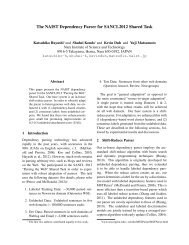file - ChaSen - 奈良先端科学技術大学院大学
file - ChaSen - 奈良先端科学技術大学院大学
file - ChaSen - 奈良先端科学技術大学院大学
- No tags were found...
Create successful ePaper yourself
Turn your PDF publications into a flip-book with our unique Google optimized e-Paper software.
tion type identification.Extraction of Descriptive AnswerAchieving a descriptive answer required in question-answering (DQA) poses manydifficulties. Examples of descriptive answers (DAs) include a How-to, a Condition,a Definition, an Opinion, a Reason and so forth. These answer types define typesof questions. How do we extract these answers from their source articles? Firstly,we have to determine the DA boundary in a source article, Answer Segment.Secondly, we have to set various parameters to select relevant answers for theuser query from variants of correct answers, such as fineness and concreteness ofdescription, coverage of related information, degree of cross-reference between relateddocuments, required document structure, subjectivity, or credibility, basedon experience or speculation. Even if we suitably establish these conditions, wecan consider multiple relevant answers according to the discourse structures intheir answers. For instance, when we examine “Cut, boil and fill a bowl.” isthis a mere list of actions or a procedure? To deal with this type of problemcorrectly, we have to be able to recognize discourse relations, including, logicalrelations: parallelism, causality, supposition; temporal relation such as the orderof actions, spatial relations such as the role and location of the agent, rhetoricalrelations such as exemplification and definition. Simple bag of words featuresare insufficient for extracting the exact answer. Unfortunately, by current naturallanguage processing (NLP), it is too difficult to solve all these problems.There are two possible alternatives of condition setting of DQA. The first oneis a restriction of a specific domain, such as cooking recipe [40, 121]. The secondis restriction on the style of answers [13, 30, 31]. In some cases, we can exploitthe style of description frequently appearing in an answer type to narrow downanswer candidates. For instance, if we wish to know the meaning of Soba, “”, the answer style could mimic the description style of a dictionary, such as”Soba : Thin Japanese noodles made from buckwheat flour.” Therefore, if wemake preparations beforehand regarding the lexical and semantic patterns andthen match the patterns to answer candidates, there are fewer and more relevantanswer candidates to sort through. If we could also find a style that is dominantin a descriptive answer type, the style would possibly work well to identify correct4


